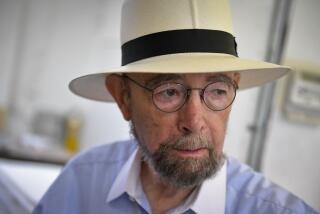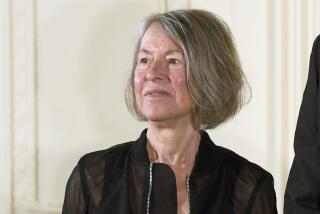A Seussian pair of shoulders
- Share via
SAN DIEGO — Near the end of his life, Theodor “Dr. Seuss” Geisel sat down with his wife, Audrey, to speak of the past and of things to come.
“ ‘I’ve had a wonderful life,’ ” Audrey Stone Geisel recalls him saying. “ ‘I’ve done what I had to do. I lived where I wished to live. I had love. I had everything.’
“ ‘But,’ he said, ‘now my work will be turned over to you. And you will have to deal with those consequences.’
“And oh-ho,” says the 82-year-old heiress of the Seuss world, “has that been true!”
Nearly 13 years after her husband’s passing, Geisel leads the global enterprise that has sprouted from Seuss’ beloved books -- watching over the Cat in the Hat, the Grinch and all the other critters and characters who live on in movies, toys, games and ventures that perhaps not even the imaginative doctor could have envisioned.
Ted Geisel came into the world in 1904, when children learned from sterile primers. In 1937, Geisel had just suffered his 27th rejection for his first children’s book, “And to Think That I Saw It on Mulberry Street,” when he bumped into a friend who worked for Vanguard Press.
“Ted told him that he’d been refused all of these times and he was going home to burn it,” Audrey Geisel says.
The encounter, of course, led to publication. The book created a stir among teachers and parents who feared it would encourage children to lie. “It was so off the wall,” Geisel says. “They even thought, ‘Oh, it might teach a child to fib,’ instead of imagine, you see? There’s the difference.”
The book did become a hit and over the years Dr. Seuss became one of the most popular children’s authors ever. He published 44 children’s books in more than 20 languages, and one book not for children, “The Seven Lady Godivas,” which was not a hit. More than 500 million copies of them have been sold.
Audrey Geisel is presiding over a year’s worth of ceremonies celebrating “Seussentennial: A Century of Imagination.”
The events include the debut of a Postal Service stamp; a tour of theatrical performances and children’s workshops across 40 cities; a series of Dr. Seuss celebrity book reviews; exhibits of items from the Dr. Seuss archives and of Ted Geisel’s art; the unveiling of a Dr. Seuss sculpture at the Geisel Library at the University of California, San Diego; and the presentation of a star honoring the author on Hollywood’s Walk of Fame.
As she gazes toward the Pacific from her hilltop home, her blue eyes a shade lighter than the waters below, Geisel says she understood the weight of the job immediately upon inheriting it, but was surprised by how it steadily grew heavier.
“And then suddenly, I had so much to do each day,” she says, describing business responsibilities as well as her philanthropic work as head of the Dr. Seuss Foundation. “But I’ve complicated my own life to a degree, and I don’t deserve much sympathy.”
Geisel is a disciplined and opinionated leader, whose mission is largely to protect the integrity of her husband’s creations. Unwilling to accept the traditional La Jolla socialite’s life of lunches, Geisel, a former nurse, instead holds court early each morning at a nearby hotel restaurant, arriving in her faithful 1984 Cadillac with the personalized license plate: GRINCH.
As president and CEO of Dr. Seuss Enterprises, Geisel is tough on those encroaching on Seuss trademarks and copyrights. And when she wanted to have the local Old Globe Theatre produce “How the Grinch Stole Christmas” years ago, she went to New York to free the miserly character from a production that later evolved into “Seussical.” Geisel had high hopes for the 2000-01 Broadway musical, but poor reviews doomed the musical in New York. It later won a second life on tour.
There have been greater successes, namely the 2000 film version of “The Grinch” starring Jim Carrey. Taking in $260 million domestically, it was the year’s highest-grossing movie.
But Geisel remains soured by her most recent Hollywood experience where, she says, Universal forced Mike Myers into the lead role of “The Cat in the Hat.”
“Oh! Now, you’re talking!” she says with a grunt. “I never saw ‘Austin Powers,’ but I knew ‘Yeah, baby!’ and I didn’t want ‘Yeah, baby!’ at all,” she says imitating the Myers’ character.
Myers, she says, was not fit to play the lanky “puddy cat” who is prone to suavely twirling his tail. Myers did not respond to requests for comment.
The movie was judged by some critics as the worst of 2003, she notes. Geisel says she will never again allow Hollywood to portray Seuss characters in live action. An animated work based on the elephant character Horton will be the next film project.
“But I’m not ready to do anything for a little bit,” she says. “I think you have to take a rest. You have to step back and not flood the market.”
In a world buzzing with action, she says, it is all the more important to share with children the original seed of the Seuss enterprise: those nonsensical yet completely sensible words.
“Just to have their favorite Seuss story read to them by a parent, that is the most calming, uniting, understanding thing that one generation can share with an oncoming generation.”
More to Read
Sign up for our Book Club newsletter
Get the latest news, events and more from the Los Angeles Times Book Club, and help us get L.A. reading and talking.
You may occasionally receive promotional content from the Los Angeles Times.









